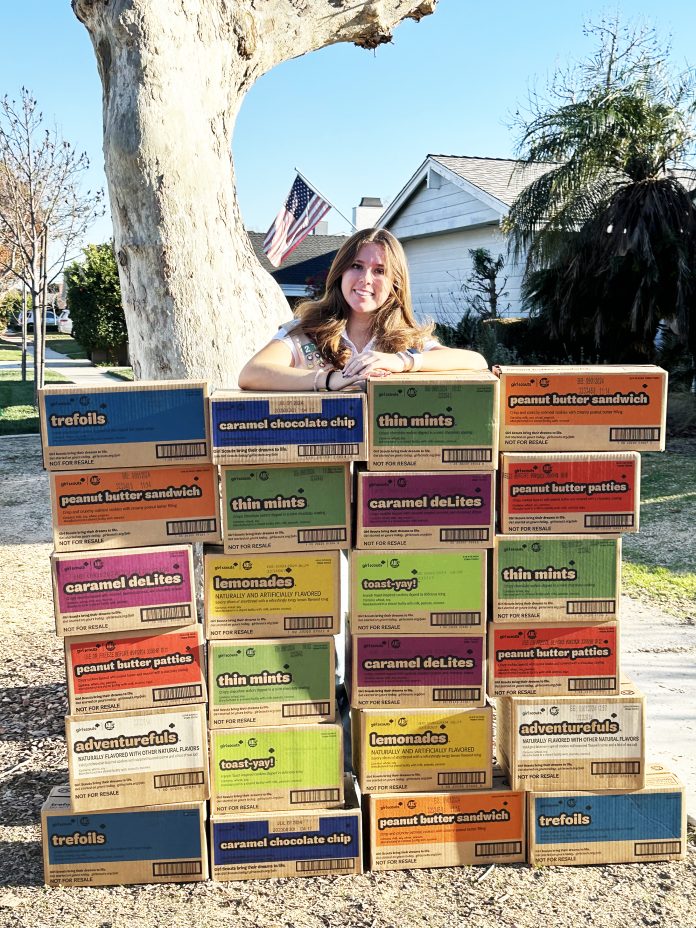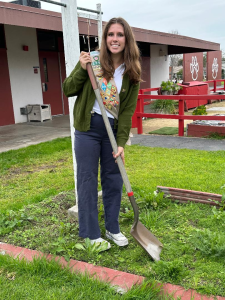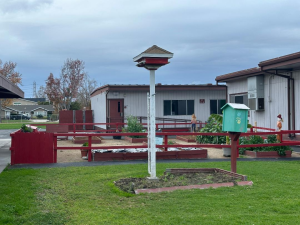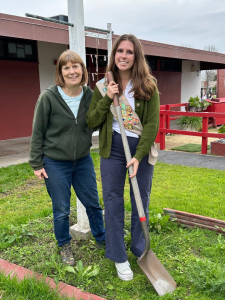
Every spring, Zoe Rannau is one of more than two million Girl Scouts who sell cookies.
Since her earliest days in kindergarten at Lee Elementary, Zoe has always been a Girl Scout and perhaps has sold more Girl Scout Cookies than any other scout in America.
Now a senior at Los Alamitos High School, Zoe has finally reached the pinnacle of Girl Scouting, seeking her Gold Award, which is the Girl Scout equivalent to an Eagle Scout.’To achieve its highest honor, scouts must complete an original project that models good civic behavior and giving back. And according to Zoe, Girl Scouts differ from Boy Scouts on this.

Courtesy photo
For Boy Scouts Eagle Scouts, said Zoe, “the main thing is you have to do is create projects that help the community in some way. And the Girl Scouts big thing that kind of differs from the Boy Scouts is that our projects must be sustainable,” she added.
“And our project has to keep helping the community for the ongoing future,” said Zoe.
It can’t just be like a one and done type project.”
Accordingly, Zoe has chosen to build a preservation habitat to protect the Monarch butterfly, which surprisingly is nearly extinct in California.
“So basically, I’m making a butterfly garden to help out endangered monarchs recently in the past few years put on the endangered species list. And so this butterfly garden will help preserve them and also kind of help educate people on preserving their life and their importance of them in nature,” said Zoe.
According to a CNN report, Western monarch butterflies are gorgeous and majestic, yet could be extinct in California in a few decades. The report noted the population of Western monarch butterflies has plunged by 86% since late 2017 in coastal areas of California.
“The dire number comes from counts of brilliant black-and-orange insects conducted every Thanksgiving by the Xerces Society, an international nonprofit dedicated to preserving invertebrates and their habitats. Monarch butterflies migrate to California and spend winters there,” the report said.

Courtesy photo
“It’s worse than anyone had anticipated,” the Xerces Society says in a post on its website.
So, this Girl Scout wants to make a difference.
Moreover, Zoe has chosen to build her butterfly protection habitat where learning all began for her, Lee Elementary School, where her parents enrolled her in kindergarten.
There is a garden already there, which Zoe ironically helped build 13 years ago in kindergarten. Now, to earn her Gold Award, she will build a butterfly protection habitat across from the garden. She and her mom Elizabeth met with the school administrations to get permission, said Zoe.
“Basically, there’s an existing vegetable garden (at Lee Elementary) that I actually helped to build, once upon a time years and years ago,” said Zoe. All those many years ago, little Zoe helped build the garden that still stands on the site.

Courtesy photo
“But on the other side of this garden, across the walkway, I’m going to build another garden that’s just dedicated to butterfly preservation,” she said. “It’s going to be a little smaller than the other garden.”
“I just thought it sounds like we have a plan is to have flowers and plants and that like are specifically beneficial to the butterfly. The Monarch specifically, and then I’ll have a few signposts that kind of go through the path of it that educate people on their lifecycle, and their endangerment and the purpose behind the garden and all that.
Elizabeth, Zoe’s mom, said the technical term is a “butterfly pollinator garden,” but most people just say butterfly garden.
By the way, Xerces estimates that the population of Monarch butterflies in coastal California dropped from 148,000 butterflies in late 2017 to just 20,456 at the end of 2018.
The project is estimated to cost between $3,000 – $5,000, but with all the funding Zoe’s cookie sales have generated for her Girl Scout Troop 2790 (Rossmoor Service Unit), she thinks they will contribute enough to start.

“But because of my cookie fails, throughout the years, we have some money, like already reserved in our troop that we’ve set aside for this project. That’ll help fund it,” says Rannau.
And if there is one thing consistent about Zoe throughout her twelve years as a Girl Scout, she’s learned how to sell those cookies.
According to the Girl Scout website, the cookie sale that generates funding for troops across the nation, began as a cookie bake not only after the organization was formed in 1917.
“The American Girl,” the official Girl Scout magazine, featured in 1922 an article suggesting sales as a fundraiser and provided a simple recipe.
“In 1933, Girl Scouts of Greater Philadelphia Council baked cookies and sold them in the city’s gas and electric company windows. The price was just 23 cents per box of 44 cookies, or six boxes for $1.24,” according to the Girl Scout website.

Courtesy photo
“Girls developed their marketing and business skills and raised funds for their local Girl Scout council. A year later, Greater Philadelphia took cookie sales to the next level, becoming the first council to sell commercially baked cookies.”
Today, Girl Scouts from around the nation sell those familiar boxes of cookies to raise money for their projects. Of all her Girl Scout pursuits, selling cookies is perhaps her strongest suit.
According to her mom, Zoe has sold over 25,000 boxes of cookies throughout her career in the Girl Scouts. That’s approximately one-half a ton of Thin Mints, Lemonades, etc.
To put that into perspective, if one were to stack, one box on top of another, and so on, the actual number of boxes of Girl Scout cookies sold by Zoe would create a mountain of cookies.

Courtesy photo
If stacked straight up, Zoe’s mountain of cookies would be taller than the equivalent to two Empire State Buildings and a Statue of Liberty on top.
For Zoe, it’s no big deal.
“I wish there was like a big secret. But to be honest, I do about 50 booth sales in one cookie season, which is two months, maybe a little less,” she said.
“And yeah, so I’m doing the sales, like multiple each day every day for I think six weeks and that’s all it is.”
She’s planning her upcoming sales season, preparing to set up her “booth” in Rossmoor and she’s going to hustle to make sure she can fund her butterfly project at Lee Elementary.
“The plaques in the butterfly garden have to be made of real brass,” he said said, which is pushing up the cost of her project.
According to a study published in the scientific journal Biological Conservation, the Monarch butterfly could be extinct in two decades without intervention.
Zoe’s butterfly garden at Lee Elementary will provide a safe haven for pollination, food etc. as it will now become part of the garden landscape.
“I want to do something to help,” said Zoe. She said the plants will provide native plants beneficial to the Monarch butterfly. “So as these native species are going away, the butterflies are losing habitats and food and things that they need to survive.”
“To save a butterfly, buy a cookie,” she said.
Editor’s Note: Citizens wanting to help can reach Zoe at via email, Cookies2024Zoe@gmail.com
